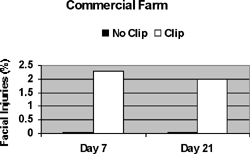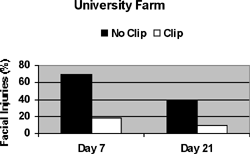
You've reached the Virginia Cooperative Extension Newsletter Archive. These files cover more than ten years of newsletters posted on our old website (through April/May 2009), and are provided for historical purposes only. As such, they may contain out-of-date references and broken links.
To see our latest newsletters and current information, visit our website at http://www.ext.vt.edu/news/.
Newsletter Archive index: http://sites.ext.vt.edu/newsletter-archive/

Effects Of Clipping Pig Needle Teeth On Sow And Pig Injuries And Performance
Livestock Update, November 2001
Mark J. Estienne, Swine Research Physiologist, Tidewater AREC;
B. Ryan Horsley, Undergraduate Student, Va. Tech;
Allen F. Harper, Extension Animal Scientist-Swine, Tidewater AREC.
Introduction
Pigs are born with eight needle (sometimes called wolf) teeth located on the sides of the upper and lower jaws. Historically, needle teeth were clipped in newborn pigs to prevent potential damage to the sow underline and consequentially, a reluctance to allow nursing. Clipping needle teeth was also seen as a means for preventing injuries to the faces of littermates when fighting occurred (Becker, 1992).
Some producers have totally abandoned the procedure, or clip needle teeth only when sows are not milking well or if greasy pig disease is present in the herd (Reese et al., 1999). Controlled research studies examining the effects of clipping needle teeth on swine performance, however, have not been conducted. Thus, the objective of the experiment described herein was to determine the effects of clipping pig needle teeth on sow teat and/or udder injuries, pig facial injuries, pig growth rates, and pre-weaning death loss.
Materials and Methods
General. The experiment was conducted at two sites: The Tidewater Agricultural Research and Extension Center (TAREC) Swine Facility in Suffolk, VA, and Land of Promise Farms in Virginia Beach, VA.
Litters at the university facility were produced from 18 primiparous, Yorkshire x Landrace sows. Sows were housed in standard farrowing crates and during lactation had ad libitum access to feed and water. Within 24 hours after farrowing, all piglets were processed as follows: i.m. injection of 200 mg iron dextran, ears notched for identification, and tails docked. At days 7 and 21 after farrowing, pigs were vaccinated against atrophic rhinitis, pasteurella, and erysipelas. Boars were castrated at 7 days of age.
Litters farrowed at the commercial operation were from 17 multiparous, Yorkshire, Hampshire, or Yorkshire x Hampshire sows. Sows were housed in standard farrowing crates and during lactation received approximately 12 lbs. of feed daily. Females had ad libitum access to water. Within 24 hours after farrowing, all piglets were processed as follows: i.m. injection of 200 mg iron dextran, ears notched for identification, and tails docked. Pigs also received an i.m. injection of 1-ml antibiotic (Lincomix; Pharmacia and Upjohn, Kalamazoo, MI). Boars were castrated at 21 days of age.
Protocol. On each farm, litters were randomly assigned to have needle teeth clipped (CLIP; n = 18) or have needle teeth left intact (NO CLIP; n = 17) within 24 h after farrowing. Needle teeth were clipped using a sterilized side cutter. Approximately one-half of each tooth was cut off flat and damage to the gums and tongue was carefully avoided. Pigs were weighed at birth, day 7, and day 21.
At the beginning of the experiment, sows were nursing 9.8 + 0.5 (mean + SE) pigs. On day 7 and day 21, the underline of each sow was examined and the percentage of injured teats and/or udders recorded. Also on day 7 and day 21, the percentage of pigs in each litter with any injury to the face was determined.
Statistical Analysis. Data were subjected to analysis of variance using the GLM procedure of SAS (SAS Institute Inc., Cary, NC). The model included treatment, farm and the treatment by farm interaction as possible sources of variation, and took into consideration differences in litter size and pig birth weights at the beginning of the experiment. Effects were considered significant if P < 0.05. This is the probability that the numerical difference between means was actually due to chance. In other words, in the case of (P < 0.05), there is less than a 5% chance that the treatments are equal (95% chance that they are not equal).
Results and Discussion
Producers have traditionally clipped needle teeth in newborn pigs to protect sow teat and udders, and pig faces, from injuries (Becker, 1992). The current study demonstrated that clipping needle teeth decreases injuries to the sow underline. Indeed, sows nursing NO CLIP litters had 65% more injured teats and/or udders than sows with CLIP litters on day 7 (effect of treatment, P < 0.01; Figure 1). There were no effects (P > 0.05) of farm or treatment by farm interaction on the percentage of injured teats and/or udders on day 7.
By day 21, however, the percentage of injured teats and/or udders was similar between treatments (Figure 1) and there were no effects of farm or treatment by farm (P > 0.05). This finding suggests that the sow is most venerable to injuries by pigs with needle teeth during the early stages of lactation.
A treatment by farm interaction (P < 0.01) was detected for the percentage of pigs with facial injuries on day 7 and day 21. On the commercial farm, the percentage of NO CLIP and CLIP pigs with facial injuries was similar (P > 0.05) on day 7 and day 21 (Figure 2). On the university farm, however, the percentage of pigs with facial injuries was greater (P < 0.01) in the NO CLIP compared to the CLIP group on both day 7 and on day 21 (Figure 2). Our data suggest that there is farm-to-farm variation in the incidence of facial injuries caused by fighting between pigs with unclipped needle teeth.
Reese et al. (1999) suggested that facial injuries resulting from unclipped needle teeth might be more prevalent when sows are not milking well. In the current study we did not measure milk production per se. However, the high incidence of facial injuries in pigs on the university farm was probably not due to poor milk production by sows. Pig weights at the university site were good at day 7 (7.1 + 0.1 lbs.) and day 21 (16.8 + 0.3 lbs.).

Figure 1. Percentage of injured teats and/or udders on day 7 and day 21 of lactation in sows nursing litters of pigs in which needle teeth were left intact (NO CLIP) or clipped (CLIP). There was an effect of treatment on day 7 (P < 0.01, *) but not day 21 (P > 0.05).


Figure 2. Percentage of pigs with facial injuries on day 7 and day 21 of lactation on the university farm and commercial operation. Needle teeth in pigs were either left intact (NO CLIP) or were clipped (CLIP). There were treatment by farm interactions (P < 0.01) on both days. On the commercial farm, the percentage of NO CLIP and CLIP pigs with facial injuries was similar (P > 0.05). On the university farm, the percentage of pigs with facial injuries was greater (P < 0.01, *) in the NO CLIP compared to the CLIP group. Note different scales on y-axis for commercial operation (0 to 2.5%) and university farm (0 to 80%).
Moreover, weights of pigs at day 21 were 14% higher on the university farm than the commercial operation (14.8 + 0.3 lbs.) where a high incidence of facial injuries did not occur.
Shown in Table 1 is sow and pig performance for NO CLIP and CLIP litters. There were no effects of treatment, farm or treatment by farm (P > 0.05). Table 1. Sow and pig performance for litters of pigs in which needle teeth were left intact (NO CLIP) or clipped (CLIP).
| Item | NO CLIP | CLIP | SE | P |
|---|---|---|---|---|
| No.: | 17 | 18 | --- | --- |
| Pig wt. (lbs.), d 7 | 6.8 | 6.9 | 0.1 | >0.05 |
| Pig wt. (lbs.), d 21 | 15.7 | 15.9 | 0.3 | >0.05 |
| Pre-weaning Deaths (%) | 8.4 | 15.7 | 2.8 | >0.05 |
Certain husbandry procedures such as tail docking, castration and needle teeth clipping has come under public scrutiny due to animal welfare concerns. We suggest that clipping needle teeth may be warranted on some farms to prevent pig and teat injuries, but the process has no positive or negative impacts on pig and sow performance. Factors that determine the necessity of implementing this procedure warrant further investigation.
References
Reese DE, Hartsock TG, Morrow WEM. 1999. Baby pig management-birth to weaning. Pork Industry Handbook. Purdue University Cooperative Extension Service. Fact Sheet No. 18.
Becker HN. 1992. Castration, vasectomy, hernia repair, and baby pig processing. In: Diseases of Swine (Eds: Leman AD, Straw BE, Mengeling WL, D'Allaire S, Taylor DJ). Iowa State University Press, Ames, Iowa. Pp. 943-956.